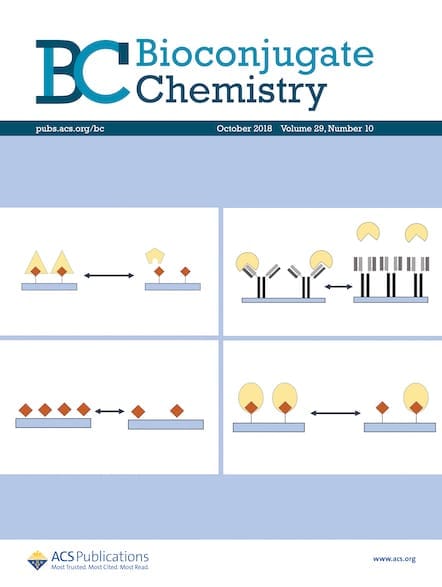Bioconjugate Chemistry and the ACS Division of Polymeric Materials: Science and Engineering are proud to announce that Dr. Chunying Chen is the winner of the 2021 Bioconjugate Chemistry Lectureship Award. This award recognizes the contributions of an individual who has made a major impact working at the interface between the biological and human-made worlds. Dr. […]

Bioconjugate Chemistry and the ACS Division of Polymeric Materials: Science and Engineering are proud to announce that Dr. Chunying Chen is the winner of the 2021 Bioconjugate Chemistry Lectureship Award. This award recognizes the contributions of an individual who has made a major impact working at the interface between the biological and human-made worlds.
Dr. Chunying Chen will join a prestigious class of past recipients, including Jason S. Lewis, Heather D. Maynard, Wolfgang J. Parak, Matthew B. Francis, and Xiaoyuan Chen.
Chunying Chen received her Bachelor’s degree in Chemistry in 1991 and obtained her Ph.D. in Biomedical Engineering from Huazhong University of Science and Technology of China in 1996. She worked as a postdoctoral research fellow at the CAS Key Laboratory of Nuclear Analytical Techniques, Institute of High Energy Physics of Chinese Academy of Sciences from 1996 to 1998. She has been the Professor and a Group Leader of the National Center for Nanoscience and Technology of China since 2006. She was elected as a General Secretary of the Asian Society of Toxicology in 2018. She is also a fellow of the American Institute for Medical and Biological Engineering, starting in 2021, and the Royal Society of Chemistry in 2016.
Dr. Chen is one of the earliest researchers worldwide in nano-bioanalysis, nanosafety, and biomedical applications. She has made a pioneering contribution and wide collaboration in fundamental research, focusing on the nano-bio interface for understanding the biomedical activities of nanomaterials and developing a new strategy to enhance nanomaterial-mediated theranostic applications, like malignant tumors and vaccine nanoadjuvants. She was recognized on the Clarivate™ Highly Cited Researchers list for the field of Pharmacology and Toxicology in 2014, 2017, and 2018. She has published six books and has been granted over 30 patents.
What does receiving this award mean to you?
It is an honor and encouragement for me. I really appreciate ACS recognition but I know that I am nothing without a team. Thus, this award is not to me only, but it’s to each of our team members, my former students, and my collaborators. Thanks for all their great contributions.
How did you first become interested in researching bioconjugate chemistry, in particular nanoparticle–protein interactions?
In 2011, we first discovered that carbon nanotubes can quickly adsorb various proteins in the blood and impact the protein structures in the circulation system, thereby reducing the biological toxicity of carbon nanotubes. At that time, few people paid attention to this field. In recent years, more scientists in the nanotechnology field have realized the importance of the nano-protein interface. It’s a good trend that more studies have focused on the development of ultimate solutions to solve this basic scientific challenge.
How would you describe your research to someone working outside the field?
The nanoscale materials have unique physiochemical properties compared to the bulk materials and have been widely applied in thousands of products in our daily life, including health, medicine, food, cosmetics, etc. Our researches try to figure out how the nanomaterials interact with the biosystems and whether these interactions induced effects are safe for human health. These researches will give proper guidance to government, industry, and consumers on how to better use nanomaterials in the near future.
What are you working on currently?
Currently, we are working on revealing the influence of the nanoparticle-protein interaction on the in vivo fate of nanoparticles. We have proposed a strategy by integrating multidisciplinary state-of-the-art techniques, such as in-situ characterization of the protein corona, metabolic analysis methods, proteomics, and molecular dynamics simulation, to study the whole in vivo metabolism and chemical transformation of nanomaterials. It is firstly reported the unique protein corona-bridged transport–transformation–bioavailability chain of nanomaterials and proved the process and mechanism of the bioavailability of nanomaterials bearing essential trace elements.
What do you think is the biggest challenge currently in your area of research?
The biggest challenge currently in nano-bio interface is lack of the advanced, accurate and in situ techniques for a deep understanding of the important nano-bio interfaces that occurred in complicated biological systems.
What advances do you hope to see in your field over the next decade?
I hope the deep understanding of the nano-bio interactions along the entire pathway of nanomaterials in vivo can be implemented. And safe-by-design approaches for nanomaterial development and innovation enable more and more theranostic applications transferring to clinical applications in the future, like malignant tumors and vaccine nanoadjuvants.
